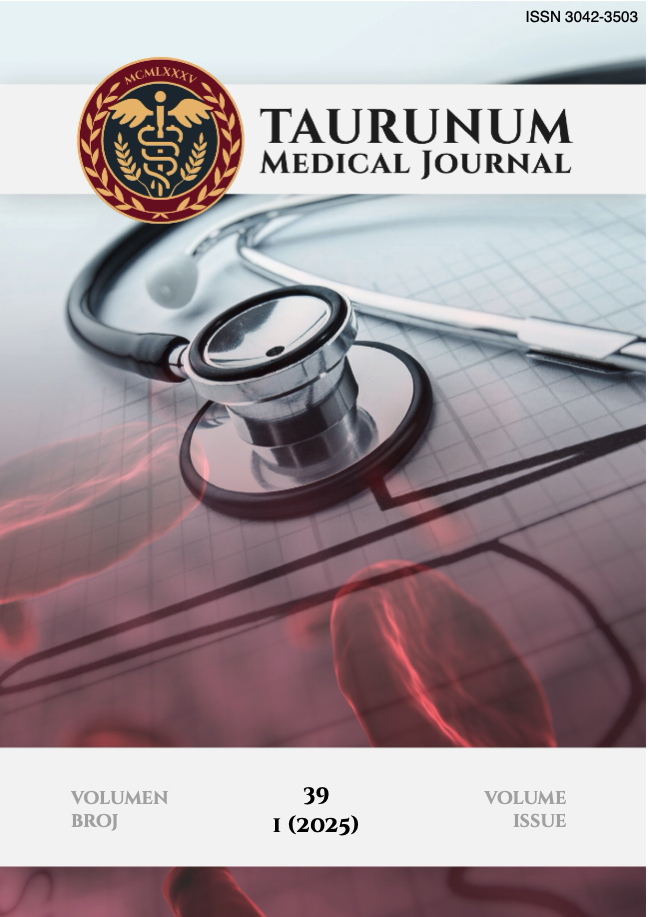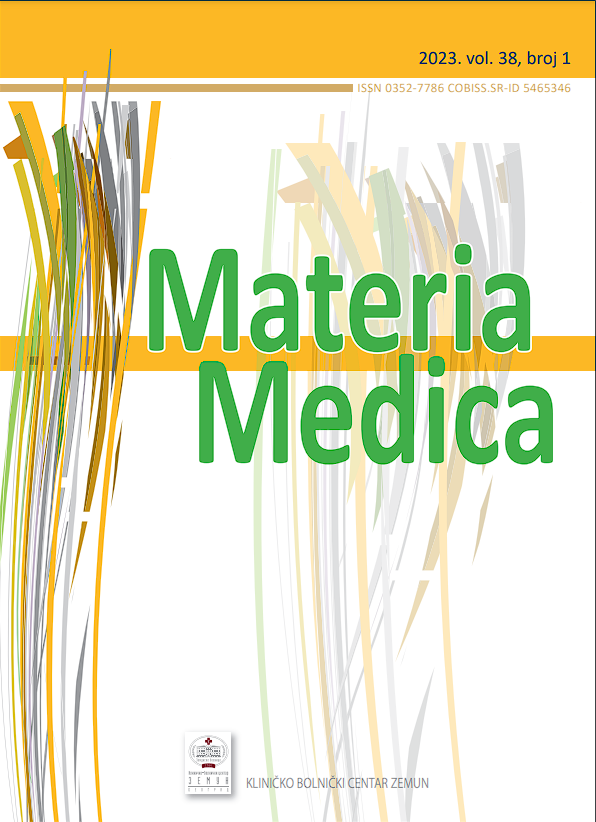Current issue

Volume 39, Issue 1, 2025
Online ISSN: 3042-3511
ISSN: 3042-3503
Volume 39 , Issue 1, (2025)
Published: 31.03.2025.
Open Access
Welcome to Issue 39, No. 1 – the first of our two annual publications for this year. Inside, you'll find a curated selection of articles. Start your year with the essential knowledge and perspectives offered in this timely edition
All issues
Contents
01.01.2023.
Seminars
Histological techniques: Immunocytochemical staining
The aim of this seminar is to present the basic methodologies of immunocytochemical and immunohistochemical staining, prerequisites for success in their performance and the practical importance of their application in routine practice. The main difference between ICC and IHC is that IHC is performed on tissue without destroying the histological architecture and it is possible to analyze the expression of molecules in the microenvironment as well. Immunochemical staining is a powerful technique routinely used to detect, localize, and quantify (quantify) cellular macromolecules in preserved tissues. Regardless of the specific method used, the first step of this technique is always the selective binding of the primary antibody to its specific antigen. Immunohistochemistry (IHC) is a method used to determine the expression of biomarkers in tissue. It is used for research and diagnostic purposes in pathology and core branches of medicine.
Dimitrije Milenkovic, Vanja Stanojevic, Biljana Drobac
01.01.2021.
Case Report
COVID19 polyneuropathy therapy with high doses of alpha-lipoic acid- Case report
The aim of our work is to acquaint other fellow physicians with our experience in prescribing high doses of ALA to which there was only a therapeutic response in terms of significant reduction of neuropathic ailments in our patients. We continued the therapy for six months after the introduction, because the difficulties are still maintained, now in a very mild form. COVID-19 disease caused by the SARS-CoV-2 virus was first described in December 2019 in Wuhan, China, but has since spread rapidly globally. Although the number of cases and deaths has attracted a lot of media attention, less attention is paid to the long-term tribute taken by those who survived the disease Since the discovery, there have been more and more reports linking SARSCoV-2 infection to various nervous system disorders. These disorders can be broken down into processes that affect the brain and spinal cord that make up the central nervous system or CNS, as well as those that affect the peripheral nervous system or PNS. Every day we learn more about the spectrum of neuromuscular disorders that develop after COVID-19 disease. We present two patients with polyneuropathy after proven SARSCoV-2 virus infection, aged 37 and 45, without previous chronic diseases that may be associated with peripheral nerve damage. The dominant symptoms in both patients are weakness and unpleasant sensations in the hands and feet, fatigue and general weakness. Therapy with high doses of alpha-lipoic acid has led to a significant reduction in discomfort and improved quality of life of patients.
Željko Kaganović, Sladjana Pavic, Zorica Tanasković
01.01.2021.
Case Report
Intra-abdominal abscess as a rare complication after Cesarean section: a case report
We present the case of a young mother, 21 years old, who developed an intra-abdominal abscess 2 weeks after the caesarean section. Postpartum abscess after caesarean section is rare (≤1%), but potentially a very serious complication. It usually occurs as a consequence of inadequate or delayed treatment of postesectional endometritis. Risk factors are younger age, lower socioeconomic status, multiple vaginal examinations and length of caesarean section. The causes are anaerobic and Gram-negative bacteria. Clinical symptoms are variable, nonspecific and present as fever, abdominal and pelvic pain, signs of peritonitis, tachycardia, tachypnea, and generalized weakness. Complications include septicemia, fistula formation, multiorgan dysfunction, and even death. Ultrasound examination is the initial diagnostic method that can confirm the existence of a purulent collection. In case of diagnostic dilemmas, an urgent CT examination is indicated.
Svetlana Kocic, Mladen Jovanovic, Predrag Popovic, Nikola Kolarovic
01.05.2021.
Case Report
Cerebralni vasculitis caused by Toxocara canis: Case report
We present a case of cerebral vasculitis and suspicious retinal vasculitis of a thirty-five- year old, HIV-negative woman. Toxocara canis is a ubiquitous parasite found worldwide. She can only complete lifecycle in dogs, and humans are accidental hosts. Among the neurological and neuropsychological disturbances produced by Toxocara infection, in humans, the most representative are meningitis, encephalitis, myelitis and cerebral vasculitis. Predominant symptoms were trembling and tingling in the left side of the body, tremor of the hands and weakness of the extremities, more to the left, fever and visual disturbance. MR imaging of the brain showed obliterative endarteritis to the left. Visual acuity was impaired, the optic nerve was swollen and macula was thickened. Antibodies to Toxocara canis were detected by ELISA test. Antiparasitic therapy with corticosteroids has led to the reduction of symptoms and clinical findings.
Sladjana Pavic, Zeljko Kaganovic
01.05.2021.
Case Report
Arrhythmic mitral valve prolapse: case report
Mitral valve prolapse is the most common cause of primary mitral regurgitation. Arrhythmic mitral valve prolapse is a special entity that is characterised by ventricular arrhythmia and increased risk for sudden cardiac death. We present a 48-year old patient that was referred to our Department of Cardiology for elective invasive coronary angiography because of significant number of premature ventricular contractions observed on 24h-ECG ambulatory monitoring. Echocardiography and cardiac MRI revealed signs of arrhythmic mitral valve prolapse.
Radosava Cvjetan, Ivona Vranic, Marina Zlatkovic, Ivan Stankovic, Predrag Milicevic, Zoran Stajic, Natasa Rakonjac
01.12.2021.
Seminars
Ultrazvučni pregled bubrega: normalan nalaz i najčešće anomalije kao kontrast patološkim nalazima
Ultrazvučni pregled je prvi pregled pri sumnji na bolesti urogenitalnog sistema. Ima visoku dijagnostičku vrednost, ne koristi štetno jonizujuće zračenje i relativno je jeftin, a nedostatak je što zavisi od iskustva radiologa i kvaliteta uređaja. Bolesti bubrega čine veliku grupu oboljenja različitog uzroka, toka, kliničke slike i prognoze. Ova oboljenja najčešće su izazvana infekcijama, metaboličkim poremećajima, toksinima i drugim uzrocima, a manifestuju se kao upale bubrega (glomerulonefritis, pijelonefritis, nefrotski sindrom) i akutna, odnosno hronična smanjena funkcija bubrega (bubrežna insuficijencija).
Ultrazvuk je standardna dijagnostička metoda kod hroničnih bolesti bubrega. Omogućava prikaz parenhima i kolektornog sistema bubrega. Pored ultrazvučnog pregleda, razvijene su i druge dijagnostičke metode, kao što su intravenska urografija, magnetna kompjuterizovana tomografija i magnetna rezonanca, mešutim ultrazvučni pregled i dalje je prva i nezamenljiva dijagnostička procedura kod obojenja urogenitalnog sistema, odnosno bubrega pre svega.
Najčešće indikacije za ultrazvučni pregled bubrega su: bol u slabinama, palpabilne mase u slabinama, hematurija, abnormalni laboratorijski nalazi koji ukazuju na oboljenja urinarnog trakta, evaluacija veličine bubrega, evaluacija obstrukcije urinarnog trakta, trauma u lumbalnoj regiji, učestalo mokrenje, smanjenje klirensa urina, pečenje tokom mokrenja ili groznica, evaluacija transplantiranih bubrega, biopsija i interventne procedure, neurogena bešika i kod pacijenata koji u alergični na kontrastno sredstvo, a imaju smetnje koje nesumnjivo potiču od strane urotrakta.
Radi jasnog formulisanja patološkog nalaza od nalaza u fiziološkim granicama neophodno je poznavanje normalnog ultrazvučnog nalaza, ali i anatomskih varijeteta odnosno bubrežnih anomalija koje u suštini nisu patološki nalaz. Ovaj pregledni rad obuhvata opis ultrazvučne anatomije bubrega, tehnike ultrazvučnog pregleda bubrega kao i pregled najčešćih anatomskih varijeteta odnosno bubrežnih anomalija koje u suštini nisu patološki nalaz.
Živorad Savić, Andor Nađ
01.01.2021.
Original Article
The importance of breastfeeding infants: The educational role of the nurse
The aim of the study is to present the tasks of a nurse in educating mothers about the importance of breastfeeding. Breastfeeding is the best start to a baby’s life, because breast milk is the best food for a baby. Despite all the advantages and multiple positive effects of breastfeeding, a small percentage of breastfed children has been recorded in the world. For the purposes of this research, an indirect observational method was used - a survey. A questionnaire constructed for the purposes of this research was used as an instrument. Using the random sampling method, we included 30 postpartum mothers who underwent an education program. The research was conducted in the Health Center Podgorica, in the period from 01.07.-20.07.2021. years. According to the results of the research, 46.7% of mothers had enough information about the benefits of breastfeeding, and 46.66% of them had a problem with breastfeeding. The results show that 73.34% of respondents are educated about breastfeeding. Half of the mothers of 15 of them received the most information about natural nutrition from other mothers. 90% of mothers had a positive attitude about the importance of natural nutrition. Based on the conducted research, we can conclude that the engagement of the nurse in the issue of educating mothers about breastfeeding has improved the attitudes of mothers, but not to a sufficient extent. The results of the research show that mothers are not sufficiently educated about the importance of breastfeeding. Research shows that if mothers receive adequate information and support, they will be more willing to start and maintain breastfeeding for as long as possible. Existing studies indicate that women need effective support for breastfeeding,but many health professionals lack the necessary knowledge, attitudes and skills. The results of our study also show that it is necessary to improve the education of nurses in order to improve their skills and pass on important information to mothers about the importance and need for breastfeeding.
Sladjana Pekmezovic, Vojislav Lekic, Milka Banasevic
01.01.2021.
Original Article
Health care of patients with pressure ulcers
The aim of this paper is to determine the importance of the nurse in the assessment, prevention, treatment and education of patients with decubitus ulcers. The pressure on the thin layer of skin between the bone protrusions and the hard surface, which is higher than 25 mmHg, and which lasts longer than 2 hours, causes ischemia of local tissue (interruption of capillary circulation), and it eventually leads to permanent deterioration of soft tissue cells. Nursing care for patients with pressure ulcers or risk factors for the development of pressure ulcers is focused on all existing preventive measures that prevent, delay or slow down the onset of the disease. The initial assessment performed by the nurse must include a complete medical history, environmental assessment, and family assessment. The education of medical staff and patients must be an integral part of any preventive strategy against the development of pressure ulcers. The ultimate goal of education is to reduce the occurrence of pressure ulcers. In the research, we applied the survey method using the Questionnaire with 17 questions. We used the Norton scale to assess the risk of pressure ulcers. In a study of patients with pressure ulcers in our study, we concluded that the subjects were older, mostly over 70 years of age, and male was more prevalent. Other data (education, housing conditions, marital status, length of treatment and method of treatment, mobility, physical activity and mental status, risk factors and complications) of our study on 30 respondents agree with data from the world literature. In terms of satisfaction with health services and the work of nurses, respondents are mostly satisfied. The education of medical staff and patients must be an integral part of any preventive strategy against the development of pressure ulcers. The ultimate goal of education is to reduce the occurrence of pressure ulcers.
Ivanka Adzic, Goran Petrovic, Tanja Lazovic
01.01.2021.
Original Article
Gastrointestinal bleeding and prevention of complications: the role of the nurse
The aim of this study was to determine the importance of health care in the treatment of patients with gastrointestinal bleeding. Bleeding in the digestive tract is divided into bleeding from the upper and bleeding from the lower part of the digestive tract. Caring for patients with severe bleeding is a serious challenge. The role of the nurse and the way the patient approaches the patient in terms of care, but also recognizing the development of possible complications, is very important. Descriptive surveys were applied using a questionnaire as a research instrument. The study found that females are more represented than males, that the level of education is high and that most employees have been working for more than 5 years. The analysis of questionnaires from the second group of questions related to professional issues related to bleeding from the gastrointestinal tract showed that 80% (16) of respondents were thoroughly acquainted with the types of bleeding from the digestive tract, and that 70% (14) of respondents Bleeding from the digestive tract is influenced by hereditary and environmental factors, so that 65% of respondents know in detail and apply the nursing procedures used in cases of gastrointestinal bleeding. 95% answered that the nurse is obliged to fully recognize the symptoms of bleeding and possible complications, and that 60% of the respondents were fully acquainted with the procedures aimed at reducing pain in patients with gastrointestinal bleeding. All 100% of the respondents thought that the nurse was fully acquainted with the symptoms and signs of bleeding, with the procedures of diagnosis and treatment, as well as with dietary measures. 85% of respondents were aware of care measures related to reducing fear and insomnia in patients. 80% of the respondents thought that they had enough knowledge to provide care for patients with gastrointestinal bleeding, and 97% of the respondents thought that the patients were not enough, or not educated at all.
Sava Mitic, Goran Petrovic, Ljiljana Isakovic, Sanja Marjanovic
01.01.2021.
Original Article
Lifestyle as a predictor of obesity in children aged 7-14 years
The aim of our work is to examine the impact of lifestyle on body mass index, as well as to examine the impact of sociodemographic lifestyle factors in school children. Prevalence of overfeeding and obese children, is rapidly increasing both in the world and in our country, so obesity is gaining pandemic size. The research was conducted as a retrospective study for the period from 2011 to 2015. The respondents consist of 700 primary school students aged 7 to 14 from the territory of the municipality of Pancevo. The body mass index (BMI) - calculated on the basis of percentiles - is defined as a dependent variable in this paper ranks, categorized into four groups, as an independent variable are defined sociodemographic characteristics and lifestyle of young people. The questionnaire was formed for the purposes of this research, and dimensionality the questionnaire was confirmed by exploratory factor analysis. Between groups with different indexes body weight, there is a statistically significant difference in eating habits, leisure habits time and performing physical activity. Eating habits, leisure habits and physical activity, they are important predictors of body mass index, while school success is a predictor of lifestyle ages 7 to 14 years.
Gordana Grbic, Dejan Mitrasinovic, Dragana Kljajic, Ljiljana Simpraga, Marija Trajkov









